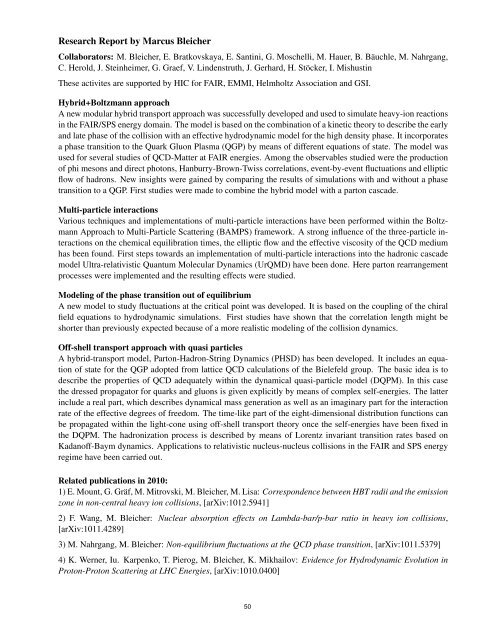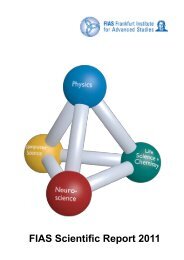FIAS Scientific Report 2010 - Frankfurt Institute for Advanced Studies ...
FIAS Scientific Report 2010 - Frankfurt Institute for Advanced Studies ...
FIAS Scientific Report 2010 - Frankfurt Institute for Advanced Studies ...
Create successful ePaper yourself
Turn your PDF publications into a flip-book with our unique Google optimized e-Paper software.
Research <strong>Report</strong> by Marcus Bleicher<br />
Collaborators: M. Bleicher, E. Bratkovskaya, E. Santini, G. Moschelli, M. Hauer, B. Bäuchle, M. Nahrgang,<br />
C. Herold, J. Steinheimer, G. Graef, V. Lindenstruth, J. Gerhard, H. Stöcker, I. Mishustin<br />
These activites are supported by HIC <strong>for</strong> FAIR, EMMI, Helmholtz Association and GSI.<br />
Hybrid+Boltzmann approach<br />
A new modular hybrid transport approach was successfully developed and used to simulate heavy-ion reactions<br />
in the FAIR/SPS energy domain. The model is based on the combination of a kinetic theory to describe the early<br />
and late phase of the collision with an effective hydrodynamic model <strong>for</strong> the high density phase. It incorporates<br />
a phase transition to the Quark Gluon Plasma (QGP) by means of different equations of state. The model was<br />
used <strong>for</strong> several studies of QCD-Matter at FAIR energies. Among the observables studied were the production<br />
of phi mesons and direct photons, Hanburry-Brown-Twiss correlations, event-by-event fluctuations and elliptic<br />
flow of hadrons. New insights were gained by comparing the results of simulations with and without a phase<br />
transition to a QGP. First studies were made to combine the hybrid model with a parton cascade.<br />
Multi-particle interactions<br />
Various techniques and implementations of multi-particle interactions have been per<strong>for</strong>med within the Boltzmann<br />
Approach to Multi-Particle Scattering (BAMPS) framework. A strong influence of the three-particle interactions<br />
on the chemical equilibration times, the elliptic flow and the effective viscosity of the QCD medium<br />
has been found. First steps towards an implementation of multi-particle interactions into the hadronic cascade<br />
model Ultra-relativistic Quantum Molecular Dynamics (UrQMD) have been done. Here parton rearrangement<br />
processes were implemented and the resulting effects were studied.<br />
Modeling of the phase transition out of equilibrium<br />
A new model to study fluctuations at the critical point was developed. It is based on the coupling of the chiral<br />
field equations to hydrodynamic simulations. First studies have shown that the correlation length might be<br />
shorter than previously expected because of a more realistic modeling of the collision dynamics.<br />
Off-shell transport approach with quasi particles<br />
A hybrid-transport model, Parton-Hadron-String Dynamics (PHSD) has been developed. It includes an equation<br />
of state <strong>for</strong> the QGP adopted from lattice QCD calculations of the Bielefeld group. The basic idea is to<br />
describe the properties of QCD adequately within the dynamical quasi-particle model (DQPM). In this case<br />
the dressed propagator <strong>for</strong> quarks and gluons is given explicitly by means of complex self-energies. The latter<br />
include a real part, which describes dynamical mass generation as well as an imaginary part <strong>for</strong> the interaction<br />
rate of the effective degrees of freedom. The time-like part of the eight-dimensional distribution functions can<br />
be propagated within the light-cone using off-shell transport theory once the self-energies have been fixed in<br />
the DQPM. The hadronization process is described by means of Lorentz invariant transition rates based on<br />
Kadanoff-Baym dynamics. Applications to relativistic nucleus-nucleus collisions in the FAIR and SPS energy<br />
regime have been carried out.<br />
Related publications in <strong>2010</strong>:<br />
1) E. Mount, G. Gräf, M. Mitrovski, M. Bleicher, M. Lisa: Correspondence between HBT radii and the emission<br />
zone in non-central heavy ion collisions, [arXiv:1012.5941]<br />
2) F. Wang, M. Bleicher: Nuclear absorption effects on Lambda-bar/p-bar ratio in heavy ion collisions,<br />
[arXiv:1011.4289]<br />
3) M. Nahrgang, M. Bleicher: Non-equilibrium fluctuations at the QCD phase transition, [arXiv:1011.5379]<br />
4) K. Werner, Iu. Karpenko, T. Pierog, M. Bleicher, K. Mikhailov: Evidence <strong>for</strong> Hydrodynamic Evolution in<br />
Proton-Proton Scattering at LHC Energies, [arXiv:1010.0400]<br />
50

















